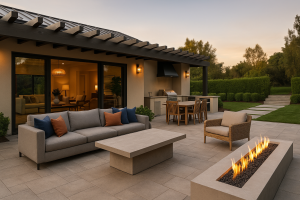As a homeowner, you may have heard the term “drip edge” before, but do you know what it actually means? In simple terms, a drip edge is a piece of metal or plastic material installed on the edges of your roof to direct water away from the fascia and prevent water damage.
But its purpose goes beyond just keeping water out of your home. A proper drip edge installation can also help protect against pests and keep your roof and siding from rotting and decaying.
The Importance of Drip Edge Installation
When it comes to protecting your home from water damage, an essential feature to consider is a drip edge. A drip edge is a metal flashing that is installed along the edges of your roof to prevent water from seeping under the shingles and causing damage to the underlying structure.
One of the key benefits of a drip edge is its ability to prevent rot and decay. Without a drip edge, water can seep into the fascia and roof deck, leading to the growth of mold and other harmful organisms. This can cause damage to the roof structure and the health of the inhabitants of the home.
Additionally, installing a drip edge can help keep pests at bay. Many pests, including rodents and insects, are attracted to damp environments, and the presence of water damage can make your home an attractive target. By preventing water from penetrating the roof structure, a drip edge can help keep pests out of your home.
The Importance of Proper Drip Edge Installation
While a drip edge is an important feature, it’s also essential to ensure that it is installed correctly. Improper installation can leave your home vulnerable to water damage, and may even void your roof warranty. In order to ensure that your drip edge is installed properly, it’s best to leave the job to a professional roofing contractor.
In addition, it’s important to choose a high-quality drip edge that is compatible with your roofing system. A reputable roofing contractor can help you select the right product for your home, ensuring that you get the protection you need.
Overall, installing a drip edge is a crucial step in protecting your home from water damage. By working with a professional contractor and choosing the right product for your needs, you can ensure that your home remains safe and secure for years to come.
Different Types of Drip Edges
When it comes to choosing a drip edge for your home, there are several different types of materials to consider. Each material offers unique advantages and disadvantages, depending on your needs and budget.
| Material | Description |
|---|---|
| Aluminum | This is the most common type of drip edge. It is lightweight, easy to install and relatively inexpensive. It is also very durable and can last for many years. |
| Steel | Steel drip edges offer superior strength and durability. They are often used in areas with high wind speeds, as they are less likely to bend or break under pressure. |
| Copper | Copper drip edges are known for their beauty and longevity. They are more expensive than other materials, but they can last for over 100 years with proper maintenance. |
| Vinyl | Vinyl drip edges are lightweight, easy to install and budget-friendly. However, they may not be as durable as other materials and can crack or fade over time. |
In addition to material, there are also different styles of drip edges to choose from. Some of the most common styles include L-shaped, T-shaped and F-shaped drip edges. Each style offers unique benefits and is designed to work with different types of roofing materials.
The Purpose and Function of a Drip Edge
A drip edge is a crucial component in protecting your home from water damage. Its purpose is to divert water away from vulnerable areas, such as the edges of your roof, windows, and doors. By doing so, it helps prevent water from seeping into your home and causing rot, decay, and other types of damage.
The function of a drip edge is to create a barrier between your roof and the fascia board, which is the horizontal board that runs along the edge of your roof. Without a drip edge, water can run down the roof and seep under the shingles, damaging the fascia board and potentially causing water damage to your home’s interior.
The Benefits of Installing a Drip Edge
When it comes to protecting your home from water damage, a drip edge is an essential component of your roofing system. Here are some of the many benefits of installing a drip edge:
- Prevents Rot and Decay: A drip edge helps keep water from seeping into the roof decking and eaves of your home, which can lead to rot and decay over time.
- Protects Against Pests: A drip edge creates a barrier that deters insects, rodents, and other unwanted pests from entering your home through the roofline.
- Preserves Your Home’s Foundation: By diverting water away from the foundation, a drip edge helps prevent erosion, which can lead to costly repairs down the road.
- Increases Your Roof’s Lifespan: A drip edge helps protect shingles from water damage, extending the life of your roof and saving you money on repair costs in the long run.
- Maintains Your Home’s Appearance: Without a drip edge, water can seep behind the gutters, causing unsightly stains and streaks on the exterior of your home. A drip edge helps keep your home looking great.
Installing a Drip Edge: A Step-by-Step Guide
Installing a drip edge is an essential part of home construction, as it helps protect your property from water damage and other hazards. While the installation process may seem daunting, it can be relatively simple with the right tools and instructions. Here is a step-by-step guide to installing a drip edge:
- Gather your materials: You will need a drip edge, roofing cement, roofing nails, a hammer, and a utility knife. Make sure you have all the necessary materials before you begin.
- Prepare your roof: Clean your roof thoroughly and ensure that it is dry before you install the drip edge.
- Measure and cut your drip edge: Measure the length of the roof and cut the drip edge accordingly. Use your utility knife to score the metal and break it along the scored line.
- Install the drip edge: Starting at the bottom of the roof, place the drip edge along the edge of the roof’s eaves, making sure it overhangs the edge by about an inch. Secure it in place with roofing nails (approximately 2 inches apart). Continue installing the drip edge along the length of the roof, making sure it is level.
- Overlap the drip edge: When you reach the end of the roof, overlap the drip edge with the starting point and secure it with roofing nails.
- Apply roofing cement: To ensure that the drip edge is completely sealed, apply roofing cement along the edge of the drip edge where it meets the roof. This will help prevent water from seeping through.
- Repeat on other roofs: If your property has more than one roofline, repeat the process on each one.
By following these steps, you can ensure that your drip edge is installed correctly and will provide your home with the protection it needs.
The Purpose and Function of a Drip Edge
A drip edge is an essential component of any roofing system and serves several key functions in protecting your home from water damage.
Firstly, a drip edge prevents water from seeping under the shingles and into the decking and fascia boards, which can lead to rot and decay. Secondly, it directs water away from the edges of your roof and into the gutters, preventing water buildup and damage to the roofline. Lastly, a drip edge prevents pests, such as insects and rodents, from gaining access to your home through gaps in the roof.
Frequently Asked Questions about Drip Edges
In this section, we will address some of the frequently asked questions regarding drip edges and provide clear and concise answers.
What is a Drip Edge?
A drip edge is a thin, L-shaped piece of material that is installed along the edges of a roof. Its purpose is to prevent water from seeping underneath the roof’s shingles or tiles, which can cause significant damage over time. Drip edges also help to channel water away from your walls and foundation, protecting your home from water damage.
Do I Need a Drip Edge?
Yes, installing a drip edge is essential for protecting your home against water damage. The cost of the drip edge is relatively low compared to the cost of repairing water damage caused by the absence of a drip edge.
Can I Install a Drip Edge Myself?
Yes, you can install a drip edge yourself if you are comfortable working on your roof and have the necessary tools and experience. However, we recommend hiring a professional to ensure that the drip edge is installed correctly and will provide adequate protection for your home.
What Materials are Used for Drip Edges?
Drip edges can be made from a variety of materials, including aluminum, galvanized steel, copper, and plastic. Each material has its advantages, such as durability, strength, and resistance to rust and corrosion. The type of material you choose will depend on your budget, roofing materials, and personal preference.
How Long Do Drip Edges Last?
The lifespan of a drip edge can vary depending on the material used, the climate, and the quality of the installation. Most drip edges should last between 20 and 30 years. However, regular maintenance and inspection can help extend the lifespan of your drip edge and ensure that it continues to provide adequate protection for your home.
Can a Drip Edge Reduce Energy Costs?
Yes, a drip edge can help reduce energy costs by preventing water from seeping into your home and causing damage to insulation and other materials. Additionally, a properly installed drip edge can help improve the overall energy efficiency of your home by preventing air leaks and drafts.
How Do I Choose the Right Drip Edge for My Home?
When choosing a drip edge, there are several factors to consider, such as the material, color, and compatibility with your roofing materials. It’s a good idea to consult with a professional roofing contractor to ensure you choose the right drip edge for your home.
Is a Drip Edge Required by Building Codes?
In most areas, building codes require the installation of a drip edge on all new roofs. The precise requirements may vary depending on your location, but installing a drip edge is generally considered a best practice for protecting your home against water damage and prolonging the life of your roof.










